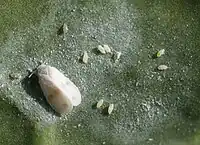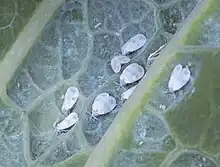Aleyrodes proletella
The cabbage whitefly (Aleyrodes proletella) is a species of whitefly from the Aleyrodidae family. It has a global distribution.


| Aleyrodes proletella | |
|---|---|
 | |
| Aleyrodes proletella with eggs on Kale | |
| Scientific classification | |
| Kingdom: | |
| Phylum: | |
| Class: | |
| Order: | |
| Suborder: | |
| Family: | |
| Genus: | |
| Species: | A. proletella |
| Binomial name | |
| Aleyrodes proletella | |
| Synonyms | |
| |
Adults are 1.5 mm in length. They have white wings with four gray spots. The wings are white due to a powdery wax. The head and thorax are dark, while the underside is yellow and also covered with a layer of wax. The eyes are red.
The species is a pest on various Brassica species (mainly Brussels sprout, kale, collard, cabbage and broccoli)[1] and Fragaria. It also feeds on various wild plants, including Capsella bursa-pastoris. It is found in colonies on the backside of leaves. They suck in the phloem of the leaves and pollute these by excreting honeydew, causing mold growth.[2]
There are usually four to five generations per year. The development of a generation varies from three to six weeks. A female can lay up to 150 eggs.
References
- "Pest Alert: Cabbage Whitefly" (PDF). Oregon Department of Agriculture. July 2016. Retrieved 25 April 2023.
- Broekgaarden, Colette; Riviere, Pierre; Steenhuis, Greet; del sol Cuenca, Maria; Kos, Martine; Vosman, Ben (February 2012). "Phloem-specific resistance in Brassica oleracea against the whitefly Aleyrodes proletella: Whitefly resistance in cabbage". Entomologia Experimentalis et Applicata. 142 (2): 153–164. doi:10.1111/j.1570-7458.2011.01210.x. S2CID 54030332. Retrieved 21 June 2022.